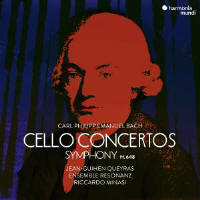Texte paru dans: / Appeared in: |
|
|
Outil de traduction (Très approximatif) |
|
|
Reviewer:
Charlotte Gardner
There can’t be
many ensembles around as stylistically fleetfooted as Hamburg’s Ensemble
Resonanz. I’m still thinking fondly back to their Haas, Bartók and Berg
programme on the Elbphilharmonie’s opening weekend; and now here they are
playing historically informed CPE Bach with equal musical sensitivity and
intellectual panache, joined by their artistin-residence Riccardo Minasi
(himself a period-performance chameleon) and their other regular collaborator,
Jean-Guihen Queyras. While this may be their first disc on Harmonia Mundi with
Minasi, they’ve already collaborated with him to record two sets of CPE Bach
symphonies for Es‑Dur. So when you top off this welloiled CPE Bach outfit with
one of today’s finest and most thoughtful periodperformance cellists, it’s no
wonder the results are magnificently fine.
Toolkit points
first, and while Ensemble Resonanz’s strings do ‘do’ gut, for this recording
they’ve gone for the more brilliant-toned metal option. Interestingly Queyras
has too, and the detailed attention he’s paid to colouring every note puts paid
to any notion that you need gut strings to present the full gamut of such
subtleties.
The tempos are
briskly flowing but never feel hurried; just enough to allow the dynamic swells
applied to the opening of the A minor Concerto (Wq170) to feel like smooth
waves; also to allow Queyras’s semiquavers in the same movement to come over as
crisp flutters and his triplet quaver figures to melt seamlessly together.
As you might
expect from Queyras, he’s written his own cadenzas. He’s also been true to form
with their length, because his A minor first-movement one is a luxurious two
minutes; which incidentally is the exact-same length of his Haydn C major
Concerto first-movement cadenza with Freiburg Baroque (10/04). Plus, while it’s
period-idiomatic for the most part, right near its start there’s an
attention-grabbing rising arpeggio sequence up into his upper harmonics that
sounds subtly but deliciously 21st-century.
Splitting up the
A minor and A major (Wq172) concertos, the ensemble and Minasi have committed
another of Bach’s symphonies to disc, this time an effervescent reading of his
Symphony in G, Wq173: a masterfully crafted work written a decade earlier than
the concertos, and possibly his first attempt at the fledgling string symphony
genre. So there are plenty of reasons to enjoy this. In fact, while I loved the punch and panache of Nicolas Altstaedt’s recent recording for Hyperion of all three of the concertos, the sheer multicoloured class on display here – and indeed its symphonic palette-cleanser – has nudged it ahead in my personal rankings. |
|




